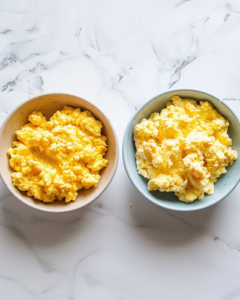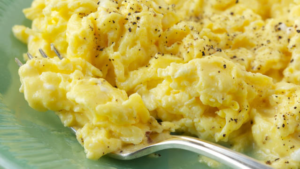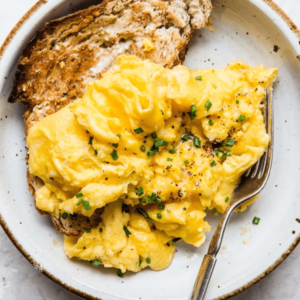Opinions are extremely diverse when it comes to the preparation of the ideal scrambled eggs. Although the dish appears to be straightforward, the manner in which it is prepared can have a significant impact on both the texture and flavor of the dish. Home cooks have been divided for generations over the question of whether or not milk should be added to scrambled eggs, which is one of the most contentious topics in the world of cuisine. My mother-in-law insists that adding milk to scrambled eggs is the best way to achieve the perfect texture, but I am convinced that doing so dilutes the flavor. So, who is in the right?

With the purpose of assisting you in selecting the approach that is most suitable for your kitchen, this article will delve deeply into both sides of the debate and analyze the rationale behind each approach. By the time you reach the conclusion, you will have a better comprehension of the ways in which milk influences scrambled eggs, as well as the method that serves your individual preferences the most effectively.
Considerations to Make Regarding the Use of Milk in Scrambled Eggs
For a great number of individuals, including my mother-in-law, the addition of milk to scrambled eggs is a universally accepted practice. When it comes to them, the most important thing is to improve the texture, flavor, and even volume. Let’s examine the most compelling reasons for including milk in the recipe.
One with a Creamier Texture
The primary reason that people add milk is to achieve a scramble that is creamier and the texture is softer. When you add milk to the eggs that have been beaten, the additional moisture from the milk contributes to a softer curd, which ultimately results in a texture that many people describe as being luxurious and almost silky. In the case of individuals who favor a scramble that is lighter and more fluffy, milk might appear to be an indispensable component.
Flavor that has been mellowed
There are some people who find the naturally rich flavor of eggs to be too much for their palate. In order to give the eggs a taste that is more neutral and balanced, milk might serve to reduce the strength of the eggs. A dish that is gentler and more palatable is created by the addition of dairy, which offers a small sweetness that helps to tone down the savory richness of eggs. This is ideal for individuals who want a more subdued breakfast.
3. An increase in the volume
When you are preparing food for a large group of people, adding milk to scrambled eggs might help you spread out the amount of servings. Due to the fact that the liquid causes the eggs to expand in volume, you will be able to offer more food without having to use additional eggs. It is a trick that can be helpful when cooking for a large gathering, even though it does not always improve the flavor by itself.
There is a strong argument against adding milk to scrambled eggs.
The argument that milk is not only unnecessary but also detrimental to the quality of scrambled eggs is one that is put forward by a significant number of purists. They are of the opinion that eggs ideally should be left alone so that their inherent flavor can be fully appreciated. They are opposed to adding milk for the following reasons.

The flavor is watered down.
In addition, the natural flavor of the eggs is diminished when milk is added, which is one of the most compelling arguments against adding milk. Rich and savory flavors are already present in high-quality eggs, but dairy products have the ability to easily cover them up. If you’re someone who enjoys the distinct taste of eggs, you could discover that milk overshadows that natural flavor, leaving you with a dish that tastes more like diluted eggs than the actual thing.
Problems with the Texture Of
There are those who believe that milk can actually result in a rubbery texture, despite the fact that proponents of milk argue that it makes the scramble flavor more creamy. Cooking eggs that have an excessive amount of liquid can take longer, and overcooking them can result in a texture that is more difficult to eat and less appealing to the general public. You might end up with something that has a more rubbery feel and a texture that is inconsistent, rather than the fluffy, soft eggs that you are hoping to achieve.
Unnecessary Component and Ingredient
Additionally, individuals believe that eggs do not require any additional components, which is another reason why they choose not to include milk in their recipe. The richness and flavor that eggs of high quality already bring to the table is sufficient on their own. When the objective is to simplify the process, adding milk or any other liquid may feel like we are meddling with perfection. The secret to making scrambled eggs that are wonderful, according to many people, is to use only eggs, butter, and a small bit of salt; there is no need for any additional ingredients.
Understanding the Science Behind It: What Effect Does Milk Have on Eggs?
In order to gain a better understanding of the reasons behind the disagreement, it is helpful to investigate the science behind scrambled eggs. When heated, the proteins in eggs coagulate, which is what gives eggs their solid structure. Eggs contain protein. In essence, the proteins are diluted when milk is added, which can result in a curd that is more pliable if it is cooked in a gentle manner. However, if the food is cooked for an excessive amount of time, the additional moisture can cause the proteins to unite more firmly, which can result in an unattractive rubbery texture.
The incorporation of milk into the mixture results in an increase in the amount of water present, which in turn lengthens the amount of time required for the eggs to cook. Achieving properly scrambled eggs without overcooking them can become more difficult as a result of this.
Alternatives to Milk for the Accomplishment of Perfect Scrambled Eggs

The following options should be taken into consideration if you are seeking for a technique to improve the texture of your scrambled eggs rather than adding milk:
In order to enhance the flavor of your scrambled eggs, several cooks suggest including a small bit of butter in the dish. Instead of watering down the flavor of the eggs, the fat in butter contributes to the creation of a creamy texture.
A dab of cream can provide the same creamy effect as milk, but with a more robust flavor. This can be used to make a scramble that is more indulgent and richer.
Without the use of milk, the addition of a small amount of shredded cheese, such as cheddar or Parmesan, not only makes the dish more decadent but also enhances the flavor.
What You Need to Know to Make Perfect Scrambled Eggs Without Using Milk
This is a foolproof method for cooking great scrambled eggs without the use of milk, so if you’re on the side of keeping things relatively straightforward:
To ensure that the yolks and whites of your eggs are thoroughly mixed together, crack them into a bowl and whisk them.
A little amount of butter should be added to a non-stick pan over medium-low heat before the pan is heated.
After pouring the eggs into the pan, wait a few seconds before stirring them to ensure that they are not disturbed.
When stirring the eggs, be careful to push them from the sides of the pan to the middle of the pan.
It is best to remove the eggs from the heat while they are still slightly runny since they will continue to cook even after they have been removed from the heat.
This approach eliminates the need for milk or any other additional liquid, resulting in a scramble that is velvety and opulent.
Conclusion: Which Method is Right for You?
Personal preference is the most important factor to consider when deciding whether or not to add milk to scrambled eggs. Some individuals enjoy the creaminess and subtle flavor that milk brings to the dish, while others are of the opinion that milk watered down the naturally occurring flavor of eggs. Skipping the milk can be the best option if you want a scramble that is more delicious and richer than the one you normally make. The addition of milk, on the other hand, can be the best choice for you if you want a smoother consistency and don’t mind a fainter flavor.
Experimenting with both practices is ultimately the most effective way to discover which group you belong to. Put your taste buds to the test by preparing scrambled eggs with and without milk and determining which variant best suits your preferences. Cooking, after all, is a personal adventure, and there is no right or wrong way to do it; the only thing that matters is what you enjoy doing the most.
